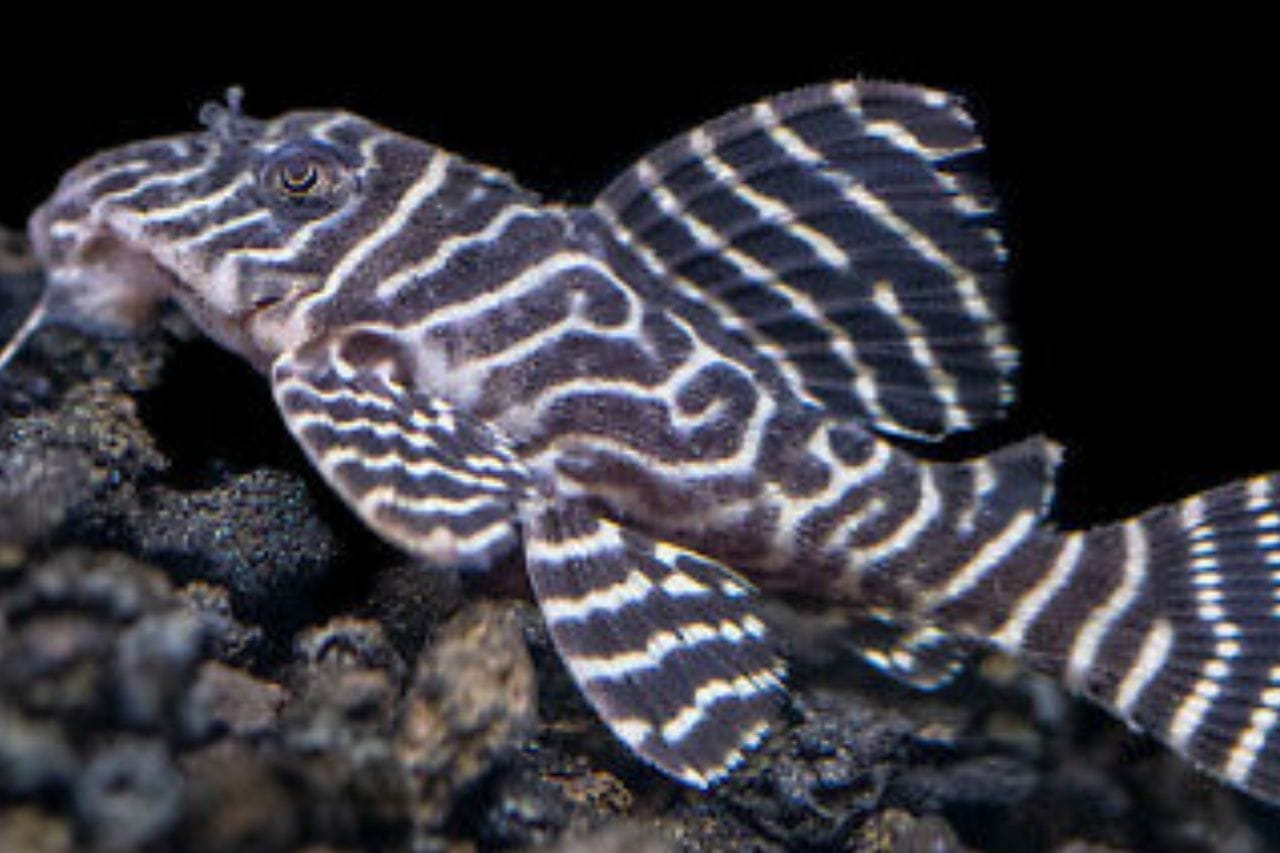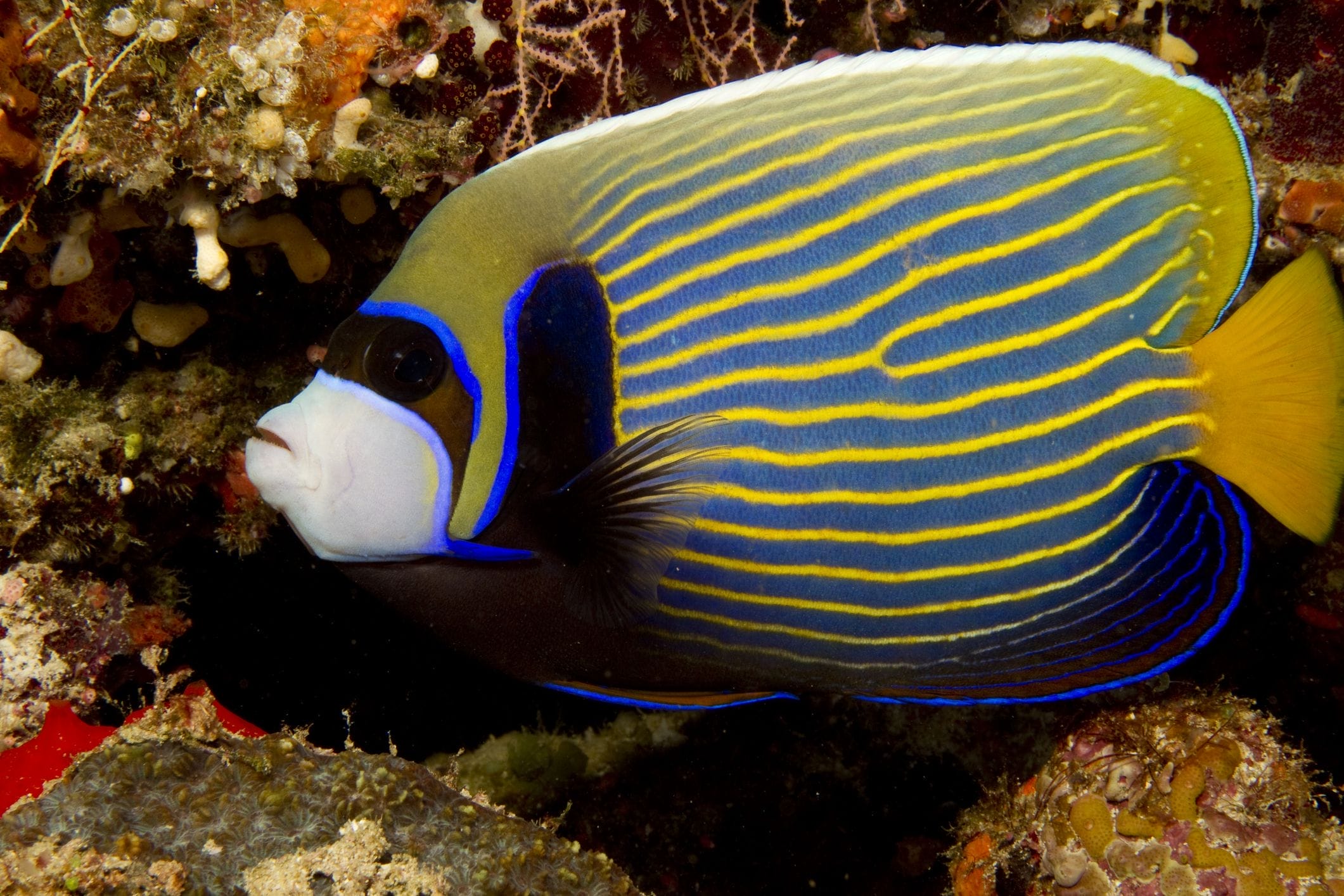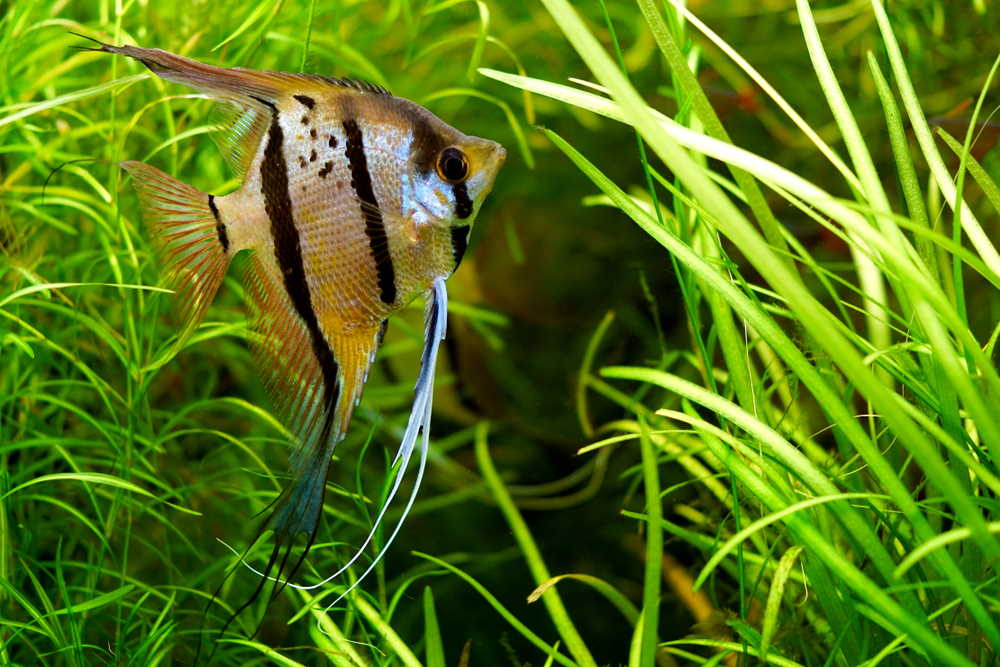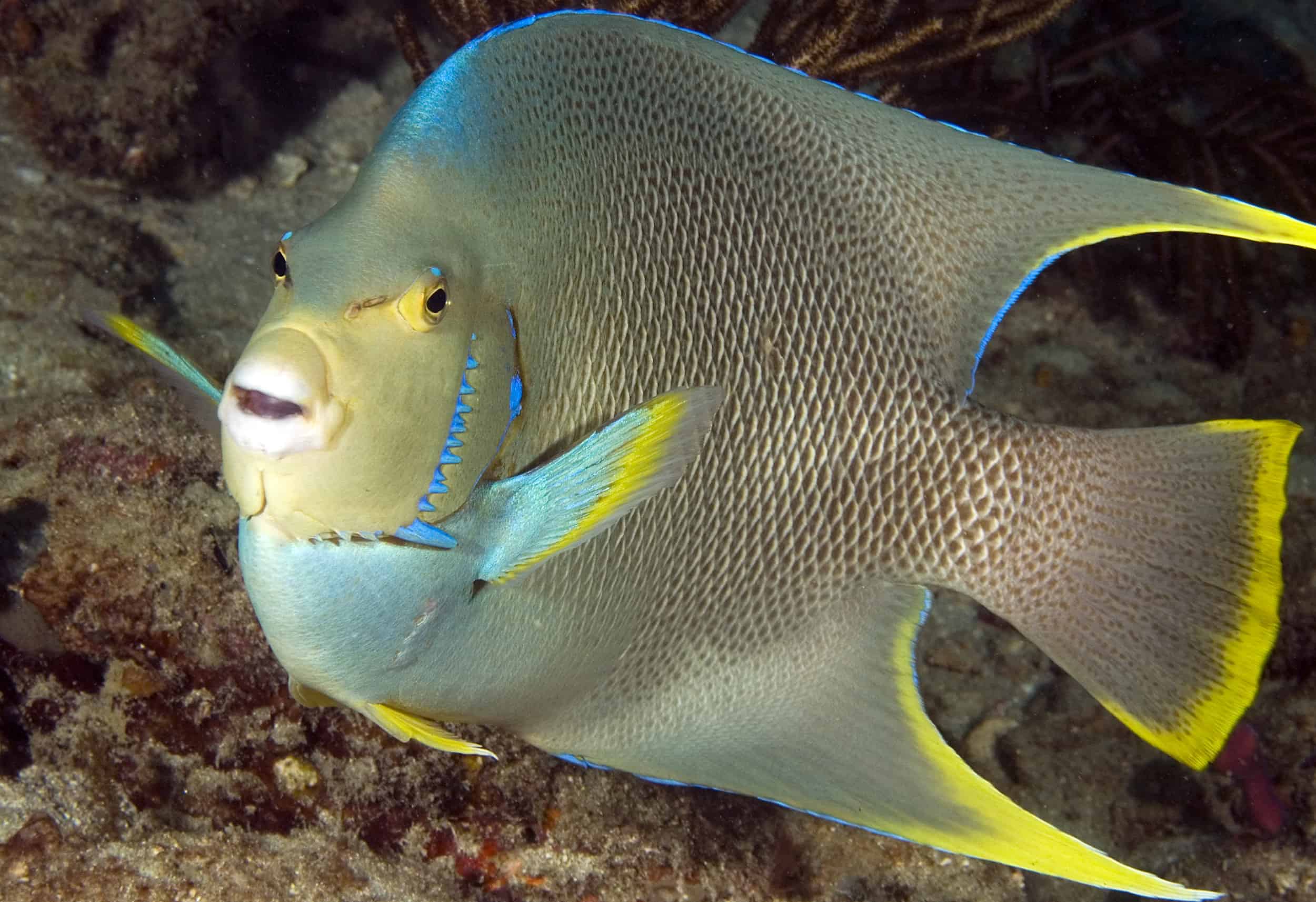
Everything You Need to Know About Angelfish

Angelfish, also known as Pterophyllum scalare, are a popular species of freshwater fish that are often found in home aquariums. With their unique shape and peaceful demeanor, angelfish make a beautiful and fascinating addition to any tank.
In this blog, we will explore everything you need to know about angelfish, from their characteristics and habitat to their care requirements and tank mates. Angelfish are known for their striking appearance, with long flowing fins and vibrant colors. They are native to the Amazon River basin and are often found in slow-moving, heavily vegetated waters. When kept in an aquarium, it’s important to provide them with a similar environment, including plenty of plants and hiding spots. When considering tank mates, it’s important to note that angelfish can be territorial and may not always get along with other fish. It’s important to avoid placing aggressive fish like rainbow sharks in aquariums with angelfish, as they may end up fighting for territory.
Whether you’re a beginner or an experienced aquarium hobbyist, this guide will provide you with valuable insights on angelfish and how to ensure their health and well-being. So, let’s dive in and discover the wonderful world of angelfish!

Angelfish: An Overview
Angelfish, scientifically known as Pterophyllum scalare, are a species of angelfish that belong to the family Cichlidae. They are native to the freshwater rivers of South America, particularly the Amazon Basin.
Angelfish are one of the most recognizable species in the aquarium hobby, thanks to their majestic fins and unique shape. Over the years, selective breeding has resulted in various color variations of angelfish, making them a favorite among fish enthusiasts. Let’s take a closer look at the characteristics that make angelfish unique.
Characteristics Unique to Angelfish
One of the most striking features of angelfish is their unique body shape. They have a triangular profile, with elongated dorsal and anal fins that extend vertically. This shape, combined with their graceful movements, makes angelfish stand out in any aquarium. The dorsal fin of angelfish is particularly prominent, while the anal fins are slightly smaller.
Apart from their shape, angelfish also come in a wide range of colors and patterns, thanks to selective breeding. You can find angelfish in shades of orange, black, silver, and even blue.
Some angelfish even have striking patterns, such as marbled or zebra-like markings. These variations in color and pattern make angelfish a visually appealing choice for aquarium enthusiasts.
Habitat of Angelfish
In their natural habitat of South America, angelfish are typically found in slow-moving rivers, flooded forests, and calm backwaters. They prefer freshwater environments with a pH level ranging from 6.8 to 7.8 and a temperature of 75-82°F (24-28°C). Here are some key points about the natural habitat of angelfish:
- Angelfish are native to the Amazon Basin in South America, specifically in countries like Brazil, Peru, and Colombia.
- They inhabit the calm, shallow areas of rivers, where they can find shelter among plants and submerged roots.
- The natural habitat of angelfish is abundant in vegetation, providing them with plenty of hiding spots and places to explore.
- Angelfish live in small groups, forming a social hierarchy within their community.
- In home aquariums, it is important to replicate the natural habitat of angelfish to ensure their comfort and well-being.
Behavior/Compatibility for Angelfish
Angelfish are peaceful fish, making them suitable for community tanks. They generally coexist well with other peaceful species of fish, provided their tank mates are of appropriate size and temperament. Here are some important points to consider about the behavior and compatibility of angelfish:
- Angelfish are known for their calm and peaceful nature, rarely exhibiting aggression towards other fish species.
- However, angelfish can become territorial during breeding, especially when they have established pairs or when there is limited space in the tank.
- They are compatible with small, peaceful fish like tetras, guppies, and barbs.
- It is important to avoid keeping angelfish with aggressive or fin-nipping species, as this can cause stress and harm to the angelfish.
- The aquarium hobby has embraced angelfish due to their striking appearance, peaceful temperament, and interesting social behaviors.
Lifespan
Angelfish have a relatively long lifespan compared to other freshwater fish species. With proper care, angelfish can live up to 10 years in home aquariums. However, their lifespan can be influenced by various factors, including water quality, tank mates, and diet. Here are some key points about the lifespan of angelfish:
- Adult angelfish, which are typically around 6 inches (15 cm) in length, have an average lifespan of 8 to 10 years in home aquariums.
- Providing stable water conditions, maintaining proper water quality, and offering a balanced diet are essential for ensuring the longevity of angelfish.
- Factors such as genetics, breeding history, and overall health of the angelfish can also contribute to their lifespan.
- Regular observation and care are necessary to monitor the general well-being of angelfish and address any potential health issues promptly.

How to Care for Freshwater Angelfish
Now that we have explored the characteristics, habitat, behavior, and lifespan of angelfish, let’s delve into how to properly care for these captivating freshwater species in a home aquarium.
Foods That Angelfish Love
Angelfish are omnivores, which means they can thrive on a diverse diet. Here are some foods that angelfish love:
- Brine shrimp: These small crustaceans are a favorite treat for angelfish, providing them with essential nutrients.
- Small crustaceans: Angelfish also enjoy small crustaceans like daphnia and copepods, which can be purchased frozen or live.
- Pellets: High-quality pellets designed for cichlids or angelfish are a convenient and nutritious option.
- Bloodworms: Freeze-dried or frozen bloodworms can be fed to angelfish as part of their diet, providing a protein-rich meal.
- Omnivorous flakes: There are specially formulated flake foods available for angelfish, providing a balanced mix of plant and animal-based ingredients.
- To ensure a well-rounded diet, it is important to offer a variety of foods to angelfish, including both live and prepared options. Feeding small, frequent meals throughout the day supports their health and mimics their natural feeding pattern in the wild.
Steps to Ensure Your Angelfish Thrive
To ensure your angelfish thrive in their home aquarium, it is crucial to provide them with the optimal conditions for their health and well-being. Here are some steps you can take:
- Maintain proper water temperature: Angelfish prefer water temperatures between 75-82°F (24-28°C). Use a heater and thermometer to monitor and regulate the temperature in the tank.
- Monitor water parameters: Regularly test the pH level of the aquarium water, aiming for a range of 6.5 to 7.5, which is considered ideal for angelfish. Also, monitor the levels of ammonia, nitrite, and nitrate, as high levels can be detrimental to their health.
- Ensure good water quality: Regular water changes, along with proper filtration, are essential for sustaining high water quality in the aquarium. Aim to change approximately 25% of the water every two weeks, or as needed, to remove accumulated toxins and maintain optimal water conditions.
- Provide proper filtration: Investing in a quality aquarium filter will help remove debris, excess nutrients, and harmful substances, contributing to better water quality and a healthier environment for angelfish.
- Maintaining stable water conditions and providing a clean, well-maintained tank are critical for the overall health and longevity of angelfish.
Tools to Keep Your Angelfish Happy and Healthy
Creating the perfect home for your angelfish involves more than just water quality and temperature control. Here are some tools and techniques to keep your angelfish happy and healthy:
- Aquarium size and shape: Consider the adult size of angelfish when choosing an aquarium, as they can grow up to approximately 6 inches (15 cm) in height and width. A tank of at least 20 gallons is recommended to provide enough space for angelfish to swim comfortably.
- Gravel and substrates: Choose gravel or substrates that mimic natural riverbeds, such as sandy or small pebbles. Avoid substrates with sharp edges that can potentially harm angelfish.
- Filtration system: A quality aquarium filter is essential for maintaining water quality and keeping the tank clean. Choose a filter that is appropriate for the size of your aquarium and consider additional filtration options, such as sponge filters or canister filters, to provide optimal water circulation and oxygenation.
- Décor and hiding places: Angelfish appreciate a diverse tank environment with plenty of hiding spots, such as caves, plants, and driftwood. Live plants not only provide shelter but also contribute to oxygenation and the overall health of the aquarium.
- Lighting: Providing proper lighting in the aquarium is important, as it mimics natural daylight and promotes the healthy growth of angelfish and live plants.
- By providing the right tools and creating a suitable habitat, you can enhance the happiness and well-being of your angelfish, allowing them to thrive in their home aquarium.
Suitable Tank Mates for Angelfish
When selecting tank mates for your angelfish, it’s important to choose species that are compatible in terms of size, temperament, and water parameters. Here are some suitable tank mates for angelfish:
- Smaller peaceful fish: Small tetras, guppies, and barbs are compatible with angelfish, as they share similar water requirements and peaceful temperaments. Avoid aggressive or fin-nipping species, as they can cause stress and harm to angelfish.
- Discus fish: Discus fish, another species of cichlid, can make suitable tank mates for angelfish, as they have similar water requirements and peaceful temperaments. However, both species require ample space and excellent water quality, so ensure your tank is adequately sized for both species.
- Invertebrates: Certain invertebrates, such as dwarf shrimp and small snails, can coexist with angelfish, provided the fish do not view them as food. Monitor the behavior of your angelfish closely when introducing invertebrates to ensure compatibility.
- When introducing new tank mates, it is recommended to observe fish behavior closely and be prepared to separate any individuals that display aggressive or disruptive behavior. Providing ample space for all tank mates and ensuring a balanced ecosystem will promote harmony in your aquarium.
Common Health Issues in Angelfish
While angelfish are generally hardy, they can still be susceptible to certain health issues. Understanding these common health problems can help you provide the necessary care for your angelfish. Some common health issues in angelfish include:
- Fin rot: This bacterial infection affects the fins, causing them to fray or deteriorate. Regular water quality maintenance and a balanced diet can help prevent fin rot.
- Ich (white spot disease): Ich is a parasitic infection that causes small white spots to appear on the fish’s body. It can be prevented through proper quarantine procedures and maintaining optimal water conditions.
- Swim bladder disease: This condition affects the fish’s ability to control its buoyancy, causing it to swim abnormally. Overfeeding and poor water quality can contribute to swim bladder disease.
- Dropsy: Dropsy is a symptom of an underlying condition, characterized by the fish’s body swelling, scales protruding, and bloating. Prompt veterinary care is essential to address this serious condition.
- If you notice any signs of illness in your angelfish, it is recommended to seek advice from a veterinarian who specializes in freshwater fish. Regular observation, water quality maintenance, and providing a balanced diet can help prevent many common health issues in angelfish.
Signs of a Healthy Angelfish
Healthy angelfish exhibit certain signs that indicate their overall well-being. Observing these signs can help you assess the health of your angelfish. Here are some indicators of a healthy angelfish:
- Vibrant colors: Healthy angelfish display vibrant colors, often with distinct patterns and markings, depending on their specific variety.
- Active swimming behavior: A healthy angelfish actively explores the aquarium, swimming with purpose and agility.
- Clear fins: The fins of a healthy angelfish are clear, undamaged, and gracefully spread, adding to their overall beauty.
- Good appetite: A healthy angelfish has a healthy appetite, eagerly consuming its food during feeding times.
- Normal breathing: Healthy angelfish exhibit smooth, regular gill movement, indicating proper respiratory function.
- Regular observation of your angelfish will help you become familiar with their individual behavior and appearance, allowing you to notice any changes or signs of potential health issues. Providing a balanced diet, maintaining water quality, and creating a suitable habitat are key factors in promoting the health of your angelfish.
Water Requirements for Angelfish
Maintaining proper water conditions is crucial for the health and well-being of angelfish. Here are some key considerations for their water requirements:
- Water quality: High water quality is essential for the health of angelfish. Regular water changes, proper filtration, and monitoring of water parameters help maintain optimal water quality.
- pH level: Angelfish thrive in a pH range of 6.5 to 7.5. Maintaining the appropriate pH level helps support their overall health and enables them to metabolize nutrients efficiently.
- Aquarium size: Angelfish require ample space to swim and explore. A tank of at least 20 gallons is recommended for a small group of angelfish, ensuring they have enough room to thrive.
- Water temperature: Angelfish prefer water temperatures between 75-82°F (24-28°C). Providing a suitable heater and regularly monitoring water temperature helps maintain stable conditions in the aquarium.
- Regular water testing and adjusting water parameters as needed will contribute to the well-being and vitality of angelfish in your home aquarium.
Heating and Lighting
Angelfish require precise temperature control to ensure optimal health and growth. Consistent water temperature can be maintained by using a heater and thermometer.
Adequate lighting is also essential for promoting healthy growth and behavior. Using a timer can help ensure consistent lighting and prevent overexposure.
It is recommended that you seek advice from a veterinarian or expert to determine the best heating and lighting setup for your angelfish, as different species have varying requirements.
Additionally, it’s crucial to monitor water quality regularly, as poor water conditions can lead to stress and illness in angelfish. By providing proper care, you can create a healthy environment for your angelfish to thrive in.
The Best Decor for Your Tank
To provide your angelfish with a comfortable living environment, it is necessary to incorporate natural-looking decor such as rocks, plants, and driftwood.
These items provide a sense of security for your fish, making them feel more at home. However, it is important to avoid sharp or rough decor that could cause damage to your fish’s fins or scales.
Keeping the tank clean and free of clutter is also critical for the health of your angelfish. This includes regular water changes and cleaning of the tank’s filtration system. A clean environment can help prevent diseases and promote optimal health for your fish.
Maintaining appropriate water conditions is equally important in creating a comfortable habitat for your angelfish. Water temperature should be kept between 75-82°F, with a pH level ranging from 6.8-7.8. Consistency in these parameters is essential as sudden changes can cause stress and illness in your fish.
In addition to decor and water conditions, providing adequate space for swimming and hiding places is also crucial. Angelfish require ample space to swim freely and explore their surroundings.
Including caves or other hiding spots can also help reduce stress in your fish by providing them with a place to retreat when feeling threatened.
Overall, creating a comfortable environment for your angelfish involves a combination of factors such as natural-looking decorations, proper water conditions, sufficient space, and hiding places. By taking these steps, you can ensure the wellbeing of your angelfish and enjoy their beauty in a healthy environment.

Conclusion
In conclusion, angelfish are beautiful and captivating creatures that require proper care and attention to thrive. Understanding their unique characteristics, habitat, behavior, and lifespan is crucial for creating a suitable environment for them.
Providing them with the right food, maintaining water quality, and ensuring suitable tank mates will contribute to their overall well-being. Regular observation and monitoring for signs of health issues are also important to keep them happy and healthy.
By following these guidelines, you can create a thriving and vibrant aquarium filled with angelfish. So, go ahead and embark on this rewarding journey of caring for angelfish and enjoy the beauty they bring to your home.





